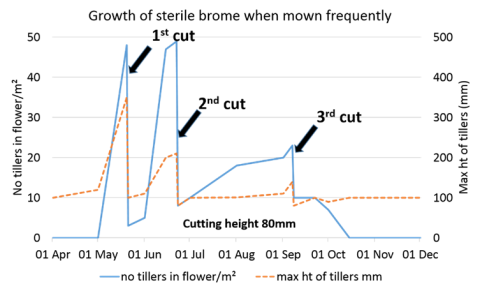Sarah Cook
Sterile brome is the most problematic species to be found mainly in field margins, but it can easily spread to the headlands and further into the field.
Sterile brome is currently producing heads and flowering, flowering usually happens between May and July, but the plant has the ability to produce heads and flower up until November. Most flowers are self-pollinated but there is some cross pollination by the wind. Seeds are viable from 3-7 days after flowering. Seed starts to shed from late June onwards. It has little dormancy, and seed starts to germinate as soon as it comes into contact with damp soil and this is increased when the seed is in darkness. Spring germinating plants can go on to produce seed in the same year.
Seed dispersal usually occurs within 1m of the parent plant, but movement of seed is helped through farming operations which tend to move it from margins into crop headlands.
The weed likes to colonise bare patches particularly in field margins, where glyphosate drift has been severe.
- Don’t let brome produce heads.
This is easier said than done, the weed wants to reproduce and will continue to produce tillers and heads even after mowing and the height of the plant will decrease (Figure 1). The best advice to initially cut high, as soon as the first heads appear. The second cut should be lower and later cuts lower still. The aim is to make the weed remain tall, if cut low in the first instance then any regrowth will be too low to mow later.

Figure 1. The number of tillers in flower and the maximum height of sterile brome tillers when mown frequently.
- Don’t have any bare patches
Margins should be sown with a competitive range of species at a time when good establishment is expected. Care should be taken not to allow herbicide drift, particularly glyphosate or other graminicides to drift into the margin killing out species and creating bare patches. Mow margins during the establishment phase to prevent brome from seeding. Brome is not very persistent and prevention of seed return for a couple of years should reduce populations significantly. As with all weed control constant vigilance is required to nip any problems in the bud.
Previously a sterile strip (chemical or cultivated) was advocated between crop and margin, but this only provides a space for the weed to establish.
- Manage crop headlands specifically to control brome
Brome tends to build up in headlands, moving out from margins. It thrives under direct drilling and shallow tillage systems. It germinates early in the autumn, from August to October. Based on this, it can be beneficial to bury the seed to a depth below which it will not germinate, this may mean getting out a plough but only cultivating around the headland. When buried at depth (15-20cms) where the soil is damp, brome is unique as its seeds undergo synchronous suicidal germination at depths below which emergence is not possible. Delaying drilling is an option so the seed can be controlled prior to drilling but don’t let herbicides drift into the margins to create bare patches.
- Don’t re-infest fields
Brome can be present in straw used for bedding and can be spread onto fields. It can also be spread through balers and combines so hygiene is important.
- Herbicide use
We have found resistance to herbicides, particularly group 2 but it is nowhere near as widespread as it is in black-grass. Applying herbicides pre-emergence or when the weed is small gives more effective control. If you are worried about resistance, then ADAS do provide a test.
- Spring cropping
Sterile brome is predominantly an autumn germinator so moving to a spring crop for a couple of years should get on top of the problem. All other rules apply with controlling it in the margins to get rid of the source of infestations and preventing spread from other sources. Sterile brome can be worse than black-grass, at high populations it is more likely to drag the crop down and yield losses can be significant. It can affect crop emergence due to competition in the autumn as it is earlier emerging, bigger and more vigorous than black-grass.
